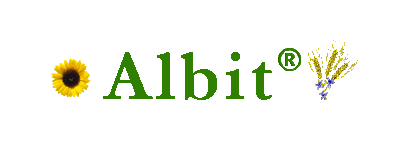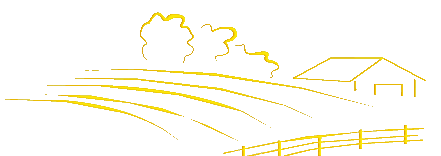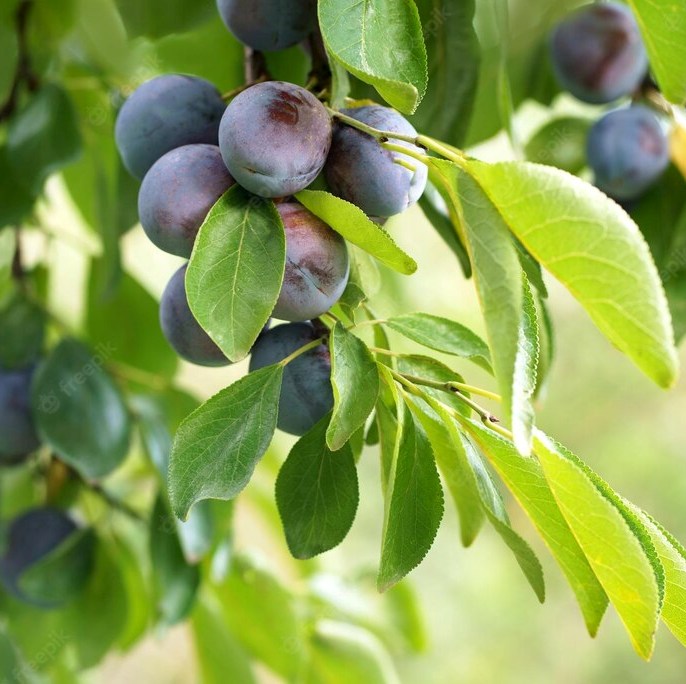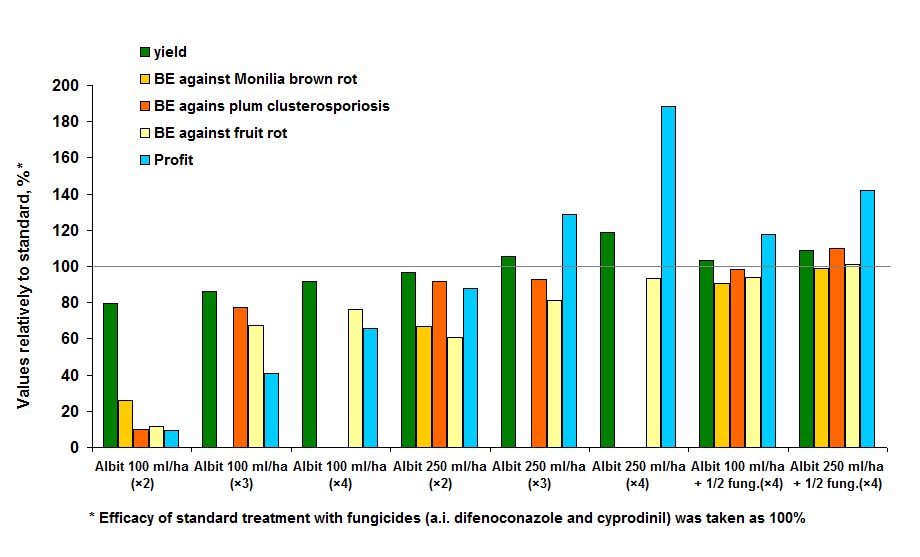|
|
Plums contain a lot of sugar (sucrose, fructose and glucose), fiber, vitamins A, C, K, B1, B2, B3, B6, E, folic acid, calcium, phosphorus, fluorine, potassium, magnesium, iron and zinc. Fresh and dried plums are rich in antioxidants, pectin, organic acids and tannins. The effect of Albit on plum has been studied in the experiments of the All-Russian Research Institute of Floriculture and Subtropical Crops (VNIITsISK, Krasnodar Territory, Sochi) since 2013. Albit can be used on plums as an antidote together with pesticide treatments. Used like this, Albit can reduce the phytotoxicity of chemical pesticides. Based on the available results of field trials conducted since 2013, Albit has a growth-stimulating effect on plum trees. Albit increases yield of plums by 0.5 to 2.7 tonne per hectare (3.5-18.6%) and works as an effective measure of protection against pathogens that target plum (brown rot caused by Monilia, plum clusterosporiosis, fruit rot). An experiment conducted by VNIITsSK in 2015 studied the immunostimulatory effect of Albit on Stanley plum infected with Monilia cinerea Bon. diseases. (brown rot), Clasterosporium carpophilum (Lev.) Aderh. (clusterosporium), Monilia fructigena Pers. (fruit rot) in subtropical conditions. Trials showed that Albit significantly improves plum growth and development. Versatile function of Albit has, in turn, a wide range of positive effects on crops. Plum shows increased resistance to phytopathogens (Monilia cinerea, Clasterosporium carpophilum, Monilia fructigena Pers.), drought and heat stress. The intensity of growth processes is stimulated, and crop yield increases. The use of Albit on plums also has high profitability. During the trials, the maximum protective effect against Monilia-caused brown rot of plum flowers was achieved with a single application of the tank mix which combined 250 ml/ha of Albit with a halved rate of the fungicide (AI difenoconazole). The intensity of disease development reduced by 3.9 times compared to control. Three treatments of plums with the tank mix of Albit (250 ml/ha) with half the rate of fungicide (AI difenoconazole, cyprodinil) proved to be highly effective against clusterosporiosis (BE 87.8-96%), exceeding the effect of commercial fungicides. Applying 250 ml/ha of Albit three times was as effective as fungicides (AI difenoconazole, cyprodinil). For ensured protective effect, Albit should be applied after flowering at the first signs of leaf damage by clusterosporiosis. Albit showed protective properties increasing the resistance of plums to fruit rot even under abnormal summer drought conditions. The biological efficiency (BE) of applying 250 ml/ha of Albit four times was 77.6-86.4%. The highest BE against the disease was reached by applying 250 ml/ha of Albit together with halved rates of fungicides four times (BE 85.1-93.4%). Carrying out the last treatment two weeks before harvest made it possible to protect the trees against fruit rot. Applying 3 to 4 treatments with 250 ml/ha of Albit in the tank mix with reduced (50% of the recommended) application rates of fungicides provided a level of protection comparable to the effect of using full rates of fungicides; therefore, reducing the costs but reaching the same effect. The highest growth of shoots was shown in the groups that were treated four times (before flowering, after flowering, during the period of fruit formation, 2 weeks before harvest) with 250 ml/ha of Albit together with halved rates of fungicides (AI difenoconazole, cyprodinil). The length of the shoots in these groups increased by 32.3% (Albit group) and 35.5% (Albit + ½ fungicide group) compared to control. The highest yield of plums was observed with four applications of Albit at a rate of 250 ml/ha. Compared to the use of highly effective commercial fungicides, Albit increased crop productivity by 2.7 t/ha (+18.6%); and by 53.6% compared to control. Combining Albit with ½ rates of fungicides yielded 3.4–9.0% more plums compared to using standalone full rates of fungicides. The maximum profitability was achieved when applying 250 ml/ha of Albit four times. Using the protection system described above, additional 60 kg/ha of high-quality fruit was obtained. Thus, the maximum production efficiency was recorded when applying 250 ml/ha of Albit four times (53.6% yield increase to control); maximum biological efficiency reached with a combination of 250 ml/ha of Albit and halved rates of fungicides (74–96% BE against diseases); highest profitability reached with applying 250 ml/ha of Albit four times (Fig. 1).
Fig. 1. Comparative production, biological and profitable efficiency of various plum treatments with Albit (VNIITsISK, Sochi, 2015).
Following the VNIITsSK report, Albit showed a pronounced protective effect against diseases, comparable to the direct effect of fungicides. In addition, using Albit proved to have high product efficiency and profitability. We recommend using Albit on plums following these regulations: spraying trees with 250 ml/ha of Albit four times: 1st time before flowering, 2nd after flowering, 3rd during the period of fruit formation, 4th – two weeks before harvest. Joint application with halved application rates of fungicides is possible. Recommended application rate of the working solution is 1000 liters per hectare. Using Albit on plums activates growth and developmental processes, increases resistance to drought, low temperature, and other adverse environmental conditions. Albit stimulates disease resistance, reduces stress, and increases the effectiveness of pesticides; it increases yield, and improves product quality. |
|
||||||||||||||||||||||||||||||||
Terms and Conditions
|
|


 Plum (lat. Prunus) is a genus of plants of the Rosaceae family. This genus includes about 250 species distributed mainly in the temperate northern regions of the globe. Many representatives of the genus are widely known fruit crops.
Plum (lat. Prunus) is a genus of plants of the Rosaceae family. This genus includes about 250 species distributed mainly in the temperate northern regions of the globe. Many representatives of the genus are widely known fruit crops.
